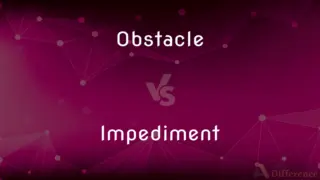Cellulose Insulation vs. Asbestos Insulation — What's the Difference?
By Tayyaba Rehman & Urooj Arif — Published on March 9, 2024
Cellulose insulation, made from recycled paper products, is an eco-friendly option, whereas asbestos insulation, derived from mineral fibers, is hazardous and banned in many countries due to health risks.

Difference Between Cellulose Insulation and Asbestos Insulation
Table of Contents
ADVERTISEMENT
Key Differences
Cellulose insulation is predominantly made from recycled paper, like newspapers, treated with chemicals for fire resistance. This makes it an environmentally sustainable choice. Asbestos insulation, on the other hand, consists of naturally occurring mineral fibers that were once admired for their fireproof qualities and durability. However, the health risks associated with asbestos have led to its decline in use.
The primary advantage of cellulose insulation is its eco-friendliness and energy efficiency. It has a high R-value, indicating strong thermal resistance, and can significantly reduce energy costs. Asbestos insulation, despite its excellent thermal and sound insulation properties, poses serious health hazards, including lung cancer and mesothelioma, due to the inhalation of its fibers.
Installation of cellulose insulation is relatively safe and can be done through DIY projects, involving blowing the material into spaces. Asbestos insulation requires professional removal due to the risks of fiber release into the air, making its management both hazardous and costly.
Cellulose insulation is treated with boric acid to enhance fire resistance and deter pests. Asbestos naturally resists fire and heat, which contributed to its widespread use before the health implications were fully understood.
Despite the initial cost-effectiveness of asbestos insulation, the long-term health care costs and removal expenses far outweigh any initial savings. Cellulose insulation, while potentially more expensive upfront, offers better long-term savings on energy bills and does not pose significant health risks.
ADVERTISEMENT
Comparison Chart
Composition
Recycled paper products
Mineral fibers
Health Risks
Low, with proper installation
High, can cause lung diseases
Environmental Impact
Eco-friendly, biodegradable
Negative, hazardous waste
Installation
DIY-friendly, blown-in or laid in batts
Requires professional removal
Fire Resistance
Chemically treated for fire resistance
Naturally fireproof
Compare with Definitions
Cellulose Insulation
Known for its high R-value, providing excellent thermal resistance.
The cellulose insulation significantly lowered our heating costs.
Asbestos Insulation
A once-popular insulation material made from natural mineral fibers.
Older homes often have asbestos insulation in their walls.
Cellulose Insulation
A sustainable insulation material made from recycled paper.
We chose cellulose insulation for its environmental benefits.
Asbestos Insulation
Requires professional abatement to safely remove.
Removing asbestos insulation from the building was a costly procedure.
Cellulose Insulation
Can be installed using a DIY approach, making it accessible.
Installing cellulose insulation in the attic was a weekend project.
Asbestos Insulation
Associated with serious health risks, including lung cancer.
Exposure to asbestos insulation can lead to severe respiratory issues.
Cellulose Insulation
Reduces energy costs by efficiently insulating homes.
Our energy bills decreased after switching to cellulose insulation.
Asbestos Insulation
Banned or heavily regulated in many countries due to health hazards.
The use of asbestos insulation is now illegal in our country.
Cellulose Insulation
Treated with boric acid for fire resistance and pest control.
Cellulose insulation is safe due to its fire-retardant treatment.
Asbestos Insulation
Offers excellent fireproofing and sound insulation properties.
Asbestos insulation was chosen for its superior fire resistance.
Common Curiosities
Is cellulose insulation safer than asbestos insulation?
Yes, cellulose insulation is considered much safer as it doesn't pose the serious health risks associated with asbestos.
Is cellulose insulation environmentally friendly?
Yes, it's made from recycled paper and is biodegradable, making it an eco-friendly choice.
Why is asbestos insulation dangerous?
Asbestos fibers can be inhaled and become lodged in the lungs, leading to diseases like mesothelioma.
Are there government regulations for using asbestos insulation?
Yes, many countries have regulations or complete bans on the use and removal of asbestos insulation.
What precautions should be taken when removing asbestos insulation?
Professional removal and abatement are necessary to avoid releasing fibers into the air.
How long does cellulose insulation last?
When properly installed and maintained, cellulose insulation can last for decades.
Can asbestos insulation still be found in homes today?
Yes, in older homes built before the widespread bans on asbestos use.
How does the cost of cellulose versus asbestos insulation compare?
Initially, asbestos might have been cheaper, but the long-term costs of cellulose are lower when considering health and removal costs for asbestos.
Is asbestos insulation effective against fire?
Yes, it is naturally fireproof, which was one of the reasons for its initial popularity.
Can I install cellulose insulation myself?
Yes, cellulose insulation can often be installed DIY, especially if you're using blown-in methods.
Does cellulose insulation require maintenance?
Generally, cellulose insulation requires little maintenance, but it should be kept dry to avoid issues with mold.
How can I tell if my insulation is asbestos?
Asbestos insulation typically requires professional testing to identify due to its hazardous nature.
How effective is cellulose insulation in terms of energy savings?
Very effective; its high R-value means it excels at keeping homes warm in winter and cool in summer.
Can asbestos insulation be overcoated with cellulose insulation?
No, asbestos needs to be professionally removed before any new insulation is installed.
What makes cellulose insulation eco-friendly?
Its use of recycled materials and biodegradability contribute to its eco-friendliness.
Share Your Discovery

Previous Comparison
Obstacle vs. Impediment
Next Comparison
Brian Lara vs. Sachin TendulkarAuthor Spotlight
Written by
Tayyaba RehmanTayyaba Rehman is a distinguished writer, currently serving as a primary contributor to askdifference.com. As a researcher in semantics and etymology, Tayyaba's passion for the complexity of languages and their distinctions has found a perfect home on the platform. Tayyaba delves into the intricacies of language, distinguishing between commonly confused words and phrases, thereby providing clarity for readers worldwide.
Co-written by
Urooj ArifUrooj is a skilled content writer at Ask Difference, known for her exceptional ability to simplify complex topics into engaging and informative content. With a passion for research and a flair for clear, concise writing, she consistently delivers articles that resonate with our diverse audience.















































